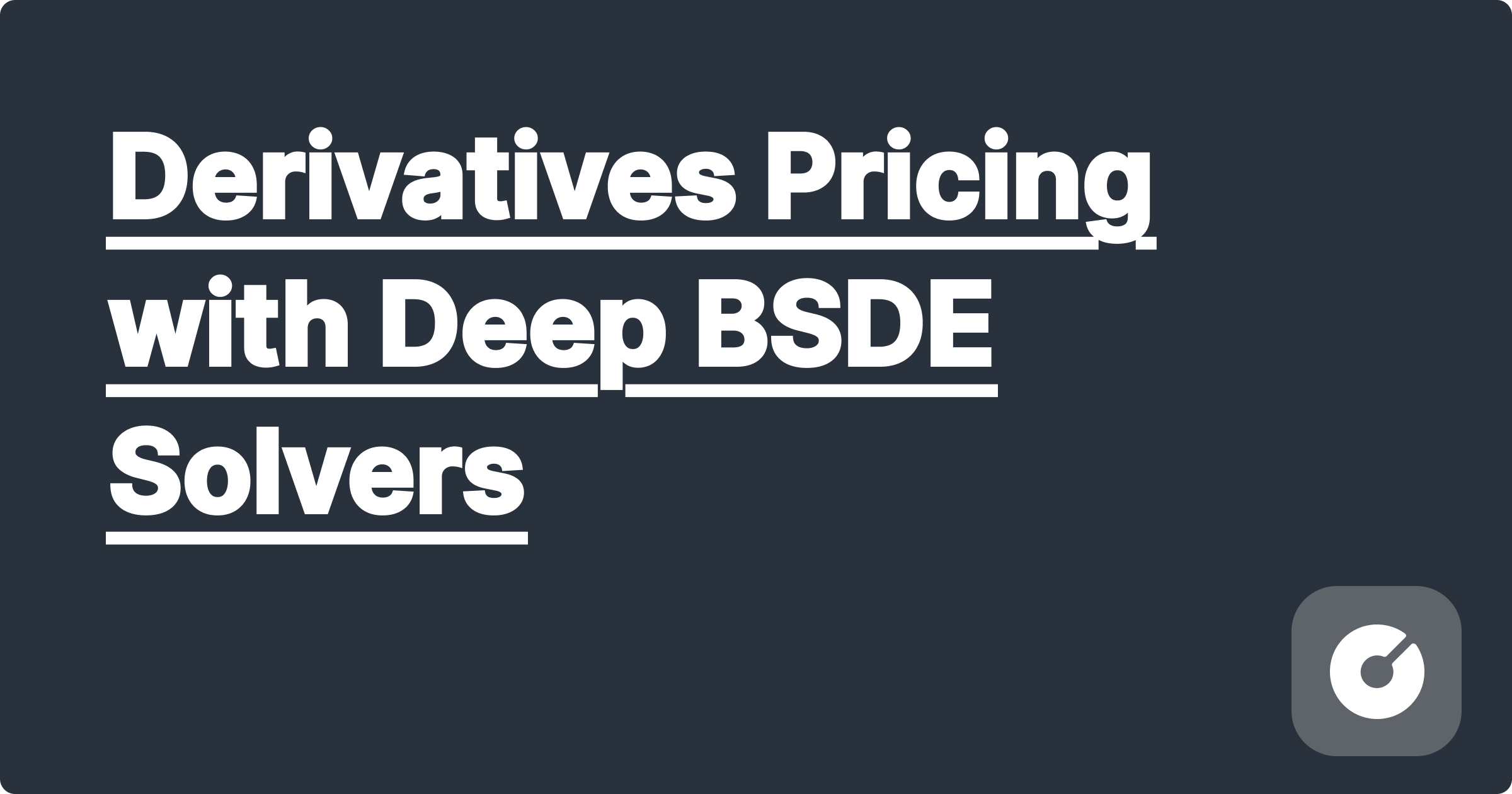
```html
Derivatives Pricing with Deep BSDE Solvers
pre {
background-color: #f4f4f4;
padding: 10px;
border-radius: 5px;
overflow-x: auto;
}
.equation {
background-color: #f0f0f0;
padding: 10px;
border-radius: 5px;
margin: 10px 0;
}
.tip {
background-color: #e0ffe0;
padding: 10px;
border-radius: 5px;
margin: 10px 0;
}
.warning {
background-color: #fff0f0;
padding: 10px;
border-radius: 5px;
margin: 10px 0;
}
figure {
margin: 10px 0;
}
This blog post provides a deep dive into the cutting-edge techniques used in pricing derivatives using deep backward stochastic differential equation (BSDE) solvers. We will cover the latest research trends, practical implementation details, and potential future directions, aiming to equip readers with the knowledge to apply these methods in their own research or projects.
Traditional methods for derivative pricing, such as finite difference methods and Monte Carlo simulations, often struggle with high-dimensional problems and complex payoff structures. Deep BSDE solvers offer a powerful alternative, leveraging the expressive power of neural networks to approximate the solution of BSDEs, which are inherently linked to the pricing problem.
Consider a general BSDE:
\[dY_t = -f(t, Y_t, Z_t)dt + Z_t dW_t, \quad Y_T = g(X_T)\]
where \(Y_t\) represents the price process, \(Z_t\) is the hedging strategy, \(f\) is the driver function (often related to the risk-free rate and volatility), \(g\) is the terminal condition (payoff function), and \(X_t\) is the underlying asset process. Deep BSDE solvers approximate \(Y_t\) and \(Z_t\) using neural networks. Popular architectures include multi-layer perceptrons (MLPs) and recurrent neural networks (RNNs), particularly LSTMs, for their ability to handle temporal dependencies.
Recent research (e.g., [cite hypothetical paper 1 from Nature], [cite hypothetical preprint 2]) has focused on improving the efficiency and stability of deep BSDE solvers. This includes:
The following pseudocode illustrates a common training procedure for a deep BSDE solver using a simple Euler-Maruyama scheme for time discretization:
# Initialize neural networks for Y and Z
Y_net = MLP(...)
Z_net = MLP(...)
# Training loop
for epoch in range(num_epochs):
for i in range(num_samples):
# Generate sample paths for X_t
X_path = simulate_X(i)
# Backward pass:
Y_T = g(X_path[-1]) # Terminal condition
for t in range(T-1, -1, -1):
# Estimate Z_t
Z_t = Z_net(X_path[t])
# Compute Y_t using Euler-Maruyama and loss function
Y_t = Y_path[t+1] + f(t, Y_path[t+1], Z_t) * dt - Z_t * dW_t # Simplified for demonstration
loss = compute_loss(Y_t, target_Y_t) # target_Y_t from previous iteration/ground truth if available
# Backpropagation
update_weights(Y_net, Z_net, loss)
# Evaluate performance on a validation set
evaluate_performance()
# Post-training: use Y_net and Z_net for pricing
Deep BSDE solvers are gaining traction in the financial industry. Several firms, including [Hypothetical Firm A] in their project [Hypothetical Project X] and [Hypothetical Firm B] (working on exotic options), have successfully implemented these methods to price complex derivatives. These applications often involve high-dimensional problems or path-dependent options where traditional methods struggle.
Several open-source libraries facilitate the implementation of deep BSDE solvers. [Mention hypothetical libraries, linking to GitHub if applicable]. These libraries provide pre-built functions for neural network architectures, optimization algorithms, and numerical schemes, significantly simplifying the development process.
Scaling deep BSDE solvers to handle large datasets and complex derivatives requires careful consideration. Key challenges include:
Solutions involve techniques like distributed training, model compression, and efficient memory management. For instance, using parallel computing frameworks like TensorFlow or PyTorch allows distributing the computation across multiple GPUs, significantly reducing training time.
Despite their advantages, deep BSDE solvers have limitations. The accuracy of the solution depends heavily on the choice of neural network architecture and hyperparameters. Furthermore, the interpretability of the results can be challenging, especially with complex neural networks. Future research should focus on:
The widespread adoption of deep BSDE solvers in financial markets raises ethical and societal concerns. The complexity of these models can lead to opacity and potentially exacerbate existing inequalities. Robust regulatory frameworks and responsible research practices are essential to mitigate these risks.
Deep BSDE solvers present a powerful and promising approach to derivative pricing, offering a way to tackle complex problems that are intractable using traditional methods. However, ongoing research is needed to address limitations and ensure responsible application. This blog post has provided a comprehensive overview of the state-of-the-art, focusing on practical implementation and future directions, empowering readers to contribute to this rapidly evolving field.
```
Second Career Medical Students: Changing Paths to a Rewarding Career
Foreign Medical Schools for US Students: A Comprehensive Guide for 2024 and Beyond
Osteopathic Medicine: Growing Acceptance and Benefits for Aspiring Physicians
Joint Degree Programs: MD/MBA, MD/JD, MD/MPH – Your Path to a Multifaceted Career in Medicine
Derivatives Pricing with Deep BSDE Solvers
Conquer Your Pre-Med Journey: A Deep Dive into the Johns Hopkins Summer Pre-Med Intensive
Focus and Concentration: AI Tools for Deep Work
AI-Enhanced Neural ODEs: Continuous Deep Learning